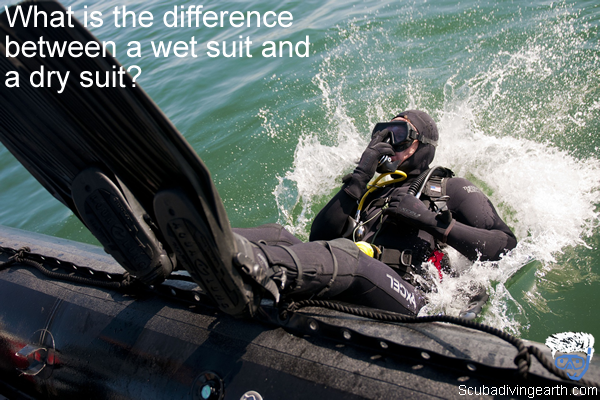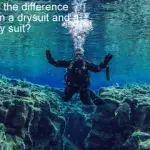
For cold water diving do you use a wetsuit or drysuit?
If you’ve only ever dived using a wetsuit, then to you maybe wondering what the difference is between a wetsuit and a drysuit. Let’s take a look at what each is, which will help to explain what the differences are.
What is the difference between a wetsuit and a drysuit? The difference between a wetsuit and a drysuit is wetsuits use a thin layer of water to keep you warm whereas drysuits use a layer of air instead. Drysuits are completely sealed to prevent water from entering, whilst wetsuits allow a thin layer of water to enter. Also drysuits are better in colder water and tend to be more expensive than wetsuits.
The best way to do more diving in your wetsuit or drysuit is to book yourself on a scuba diving liveaboard. Not all liveaboard dive destinations are warm waters, as there are a few places where a drysuit is better than a wetsuit to keep you warm (e.g. Mexico’s Guadalupe Island and The Galapagos Islands). You can check the latest and best deals on liveaboards using the following window:
Wetsuit vs Drysuit Table of Differences
| Wetsuit | Drysuit | |
|---|---|---|
| Cost | $25-$500 | $250-$3,000 |
| Water temperature | 18-29°C (64-84°F) | Below 18°C (64°F) |
| How it works to keep you warm | Thin layer of water between you and the wetsuit warms up, plus the insulating properties of the neoprene. | Staying dry combine with using insulation under the drysuit to keep you warm.* |
| Do you get wet | Yes | No |
| Buoyancy | Wetsuits are less buoyant. | Drysuits tend to be more buoyant due to the air pocket inside. |
| Buoyancy control | BCD only | Can use the drysuit or BCD for buoyancy control |
| Warmth | Wetsuits don't always keep you warm out of the water when wet. | Drysuits keep you warm both in the water and out of the water. |
| Space | Wetsuits take up less space | Drysuits are more bulky |
| Cold water diving (i.e. in ice cold water) | No | Yes |
| Warm water diving (i.e. diving in the Caribbean) | Yes | No |
| Suitable for scuba diving | Yes | Yes |
| Suitable for snorkeling | Yes | Not really |
| Suitable for kayaking | Yes | Yes |
| Suitable for surfing | Yes | No |
| Suitable for stand-up paddle boarding | Yes | Yes |
| Suitable for water skiing | Yes | Yes |
| Suitable for wake boarding | Yes | Yes |
| Additional equipment required for scuba diving | None | Hose to connect to the drysuit inflator inlet |
| Dangers | None | Inverted ascent when scuba diving |
* You need undergarments to keep you warm with crushed neoprene and membrane drysuits. But with a neoprene drysuit, it is the thick neoprene that keeps you warm.
What is the difference between a wetsuit and a drysuit in more detail
In summary, the easiest way to remember the difference between a wetsuit and a drysuit is that a wetsuit let water in, whereas a drysuit doesn’t.
But let’s list what are the main differences between a drysuit and a wetsuit:
- Wetsuits are used in warmer water temperatures than a drysuit, which are designed for colder water temperatures.
- Drysuits have better and tighter fitting seals to keep the water out. Whereas wetsuits have seals that are designed to flush water.
- Drysuits tend to be more expensive than wetsuits.
- A drysuit is effectively used as your buoyancy control device, whereas a wetsuit isn’t.
- Drysuits keep you warmer out of water and in-between dives compared to wetsuits which tend not to, especially when wet.
- Drysuits tend to be made of heavier and stronger insulating materials to help keep the wearer dry and the water out.
One important difference is how tightly fitting a wetsuit needs to be vs how tight a drysuit needs to be. So you may also like to read about how tight a drysuit should be. This article includes a drysuit fitting guide too and how to check whether it’s too tight before buying.
What is a wetsuit?
Wetsuits are made from neoprene. To help protect the neoprene from damage and from being perished by the sun it’s usually covered with a layer of stretchable material.
Wetsuits come in varying degrees of thickness starting from around 2-3mm thick.
The thickness of the neoprene affects the thermal property of the wetsuit. The thicker the neoprene, the warmer it will keep you. But there is a threshold of cold where a wetsuit will no longer keep you warm underwater, which is when a drysuit becomes a better option.
More Reading: Do You Wear Anything Under A Wetsuit? (What To Wear Male & Female)

Do wetsuits keep you dry?
Wetsuits work by using a combination of the thermal properties of the neoprene, together with the warmth gained from a thin layer of water.
This thin layer of water lies between the wetsuit and your skin. It is your body temperature that warms this thin layer of water up. Once warmed, it helps to keep you warm throughout your dive.
It is therefore the case that wetsuits do not keep you dry. You are therefore wet when you finish your dive, hence the name ‘wetsuit’.
You may like to read about how to clean a smelly wetsuit, which includes the smell of urine. There are some important do’s and don’ts’s of cleaning a wetsuit to make sure it lasts.
Do wetsuits work?
Yes wet suits work well in waters that aren’t too cold. But where a wetsuit may let you down is if you’re going to be doing a second dive. This is especially true on a cold day.
A ‘wet’ wetsuit out of water works in the opposite way to how it works underwater. If it’s a cold, wet and windy day and you’re on a dive boat, you’ll struggle to get warm in-between your dives.
When you get kitted up for your next dive and jump back into the cold sea, you’ll feel the cold much faster. When that fresh flush of cold water hits you, after never properly warming up, you may not be too happy. This means you’ll get colder much sooner.
You could opt to taking your wetsuit off in-between your dives. But whilst this will help you to warm up on your dive interval, you’ve still got to get back into a wet and cold wetsuit before your next dive. It’s extremely unlikely it will dry out in-between your two dives.
Do wetsuits keep you warm?
Yes a wetsuit will keep you warm, subject to how cold the water gets. In really cold waters you are better off using a drysuit or alternatively you could use a semi-drysuit instead.
More Reading: What is the difference between a drysuit and a semi drysuit?
Can you swim in a wetsuit?
Depending on the thickness of the neoprene of the wetsuit, it’s okay to swim in one. In fact wetsuits are used by surfers who need to paddle out to the waves. The flexibility of the neoprene allows full arm movement when swimming.
What is a drysuit?
A drysuit provides scuba divers with better thermal insulation than other exposure suits like wetsuits and semi drysuits, as the wearer is kept dry.
There are three types of drysuit. These include neoprene drysuits, crushed neoprene and membrane drysuits. Each one of these drysuits has it’s own properties and benefits or advantages vs its disadvantages over the other.
But all three types of drysuit described provide thermal protection at the same time as keeping the wearer dry.
More Reading: Does a drysuit keep you dry (What are the exceptions & do you get wet)
With a drysuit the thermal warmth is provided with three main types:
- Neoprene drysuit. The thickness and thermal properties of neoprene keep you warm. Plus the thin layer of air around your body inside the suit is what helps to keep you warm.
- Crush neoprene drysuit. It’s what you wear underneath this type of drysuit that will keep you warm, which is typically a woolly-bear. It is the thermal properties of the woolly bear, together with the layer of air inside the suit that keeps you warm. You can buy a ‘woolly-bear‘, which is a effectively a thermal onesie to keep you warm.
- Membrane drysuit. The way this keeps you warm is similar to a crushed neoprene drysuit, which is by using a thermal undergarment under the membrane drysuit.
Do drysuits keep you dry?
Drysuits are designed to keep you dry and they do. However, over time drysuits can spring a leak. Leaks can form around the wrist and neck seals or where the suit itself gets punctured.
It’s quite easy to have a drysuit repaired if it has a leak. But when you expect to be dry on a dive, it’s not a nice experience when you discover a leak when you’re underwater and cold water seeps in!
Do drysuits work?
Drysuits are designed to fit more loosely than wetsuits. They allow you to wear clothes and/or other insulation layers underneath, as explained above.
As describe previously, drysuits work by keeping an insulating layer of air between your body and the suit. It is this layer of air, combined with the insulating properties of either a neoprene drysuit or the thermal clothes under a crushed neoprene or membrane drysuit that makes it work well.
Drysuits work well in cold waters and can be used in freezing cold waters of the Arctic or Antarctic or perhaps when diving in a frozen lake.
The air in a drysuit is controlled using an inflator hose attached from your air supply to a valve on the suit. This inflator valve allows you to add air as you go deeper. This acts as your buoyancy control, instead of you using your buoyancy control device or BCD.
More Reading: How Does A Buoyancy Control Device Work? (Don’t Dive Without Knowing)
What is a drysuit used for?
As a general rule drysuits offer better insulation than wetsuits or semi drysuits. This is especially true when used in cold water and makes them more suitable for this type of use.
Drysuits are often used by commercial divers on oil rigs, by police divers who dive in cold rivers or lakes and by recreational scuba divers who dive in colder waters around the world.
But on the contrary, drysuits would be extremely uncomfortably in hot or warm air or water. So you’d never consider using a drysuit in somewhere like the Caribbean or the Red Sea.
Typically drysuits are more expensive than wetsuits or semi-drysuits. They are also a bit more complex to put on. They also require additional training before they can be used by scuba divers.
The extra training is because of the buoyancy qualities of a drysuit and the fact that when you’re drysuit-diving, the drysuit is used for buoyancy compensation rather than your BCD.
More Reading: How To Achieve Neutral Buoyancy Scuba Diving (Made Easy)
Do drysuits keep you warm?
Drysuits certainly keep you warm in cold water. But how warm you are when you’re using a drysuit is dependent on the amount of insulation you use. For example, with a neoprene drysuit, you’ll only be as warm as the thickness and thermal properties of the neoprene of the suit.
Whereas with a crushed neoprene and a membrane drysuit, you’re only as warm as the undergarments worn and their thermal properties.
The colder the water, the better the insulation is needed to compensation and to keep you warm when using a drysuit.
Can you swim in a drysuit?
Swimming in a drysuit would be quite challenging and is not generally something that is done. A drysuit is more restrictive for movement than a wetsuit is, as they are designed for comfort and warmth rather than for physical exertion
If you’re looking for thermal insulation for swimming, you’re better off using a wetsuit instead.
What do you wear under your drysuit?
As discussed earlier, with a crushed neoprene drysuit you wear warm insulating clothes. The same goes for a membrane drysuit. But for a neoprene drysuit you just wear shorts and a t-shirt.
In really cold weather and if the water temperature is really low, you’d be advised to wear two layers or better thermal insulation.
What causes drysuit squeeze?
As you dive deeper, the air inside your drysuit gets squeezed. As already mentioned, if you’re diving using a drysuit, you’re better to use the drysuit as your method to achieve neutral buoyancy than you are to use your buoyancy control device.
However, drysuit squeeze is caused on your descent. It is caused where you fail to add enough air to your drysuit during the descent. It’s not really a problem, and you soon notice it when you forget. You’ll feel it most beneath the valves and seams of the suit as these push against your skin.
To overcome drysuit squeeze is a simple matter of adding more air using the inflator hose.
More Reading: What causes drysuit squeeze? (How to prevent drysuit squeeze)
I hope you enjoyed this article about what is the difference between a wetsuit and a drysuit
I’d love to hear from you. Tell us about your adventures of diving and snorkeling, in the comments below. Please also share your photos. Either from your underwater cameras or videos from your waterproof Gopro’s!
If this article hasn’t answered all of your questions. If you have more questions either about snorkeling or types of scuba diving (or specifically about what is the difference between a wetsuit and a drysuit), please comment below with your questions.
There will also be many more articles about scuba diving (and snorkeling) for you to read and learn about these fabulous sports.
Have fun and be safe!




